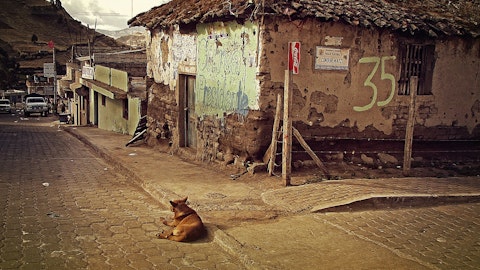In this article, we will take a look at the 20 countries with the highest agricultural population density. If you would like to skip our discussion on the trends in the agriculture sector, you can go to the 5 Countries With the Highest Agricultural Population Density.
Agriculture, often regarded as the backbone of human civilization, is undergoing a period of significant transformation. Driven by population growth, climate change, and evolving consumer preferences, the way we produce food is being reshaped. With the United Nations projecting a global population of 9.7 billion by 2050, there is an urgent need to increase agricultural output to meet the nutritional requirements of this expanding population. The Food and Agriculture Organization (FAO) estimates that food production will have to grow by 70% to feed everyone adequately by 2050.
Moreover, investing in agriculture is shown to be effective in reducing poverty compared to investment in other sectors. According to the World Bank, investing in agriculture is two to four times more impactful at lifting people out of poverty than investing in other sectors. Agriculture is the major driver for economic growth since it makes up 4% of the GDP globally. This figure goes up to 25% of the GDP in developing countries.
However, despite the importance of agricultural production, data from the US Department of Agriculture shows that the global agricultural production growth rate in the last decade declined to 1.14% per year from 1.19% a year a decade earlier. This trend is caused by an interplay of several factors. Extreme weather events, fueled by climate change, threaten to shrink average crop yields. Moreover, Russia’s invasion of Ukraine in 2022 and COVID-19 caused a further slowdown in this sector. As a result, the number of people facing food insecurity has risen to 333 million, compared to 200 million before the onset of the COVID-19 pandemic.
Precision agriculture has emerged as one of the promising solutions to address this issue. Precision agriculture employs a data-driven approach to farming, aiming to optimize yields while minimizing environmental impact. By utilizing sensors, drones, and advanced analytics, farmers can gain real-time insights into soil conditions, water usage, and crop health. This allows them to apply fertilizers, pesticides, and irrigation more precisely, reducing waste and maximizing resource efficiency. Studies by USDA show that crop yield is higher for technology adopters than for non-adopters.
Growth of the Agricultural Robots Market
Technology is rapidly reshaping agriculture, ushering in an era of smart farming characterized by increased efficiency, precision, and sustainability. For instance, robots are taking on repetitive tasks like weeding, harvesting, and milking, freeing up human labor for more strategic decision-making leading to improvements in efficiency. According to Markets and Markets, the global agriculture robots market was estimated to be $13.5 billion in 2023. It is forecasted that the market will reach $40.1 billion by 2028, with a compound annual growth rate of 24.3%. Market drivers include rising costs of labor, the push toward farm optimization, and the availability of technological advancements. Key players in the agricultural robots market include Deere & Company (NYSE:DE), AGCO Corporation (NYSE:AGCO), and AgEagle Aerial Systems, Inc. (NYSEAMERICAN:UAVS).
Deere & Company (NYSE:DE) is constantly providing cutting-edge technological solutions to the agricultural sector. It recently partnered with SpaceX to provide better connectivity to farmers and robots so that precision agricultural practices may be better utilized on farms. The company has also invested in projects of autonomous tractors and machine learning with the ambitious aim of building a fully automated world of farming by 2030.
AGCO Corporation (NYSE:AGCO) is another farm equipment company that is working towards automating agriculture. The company recently announced the finalization of its joint venture agreement with Trimble TRMB. This deal will enable the company to provide farmers with wider access to next-generation precision agriculture technologies.
AgEagle Aerial Systems, Inc. (NYSEAMERICAN:UAVS) is a leading provider of stack drones, sensors, and software solutions. It is also involved in precision agriculture. Recently, the company’s value-added reseller ALVO won a tender from the Greek Ministry of Agriculture to provide 50 RedEdge-P™ multispectral cameras. These cameras will analyze crop activity for optimization.

A combine harvesting crops, showing the capabilities of the company’s agriculture equipment.
Our Methodology
To shortlist 20 countries with the highest agricultural population density, we used data from the Food and Agriculture Organization of the United Nations (FAO). Agricultural population density is measured as the number of individuals engaged in farming, fishing, hunting, or forestry per hectare of arable and permanent cropland. Arable land refers to land used for temporary crops, while permanent cropland is utilized for farming for periods longer than five years. The countries have been ranked in ascending order of agricultural population per hectare of arable and permanent cropland. Our list excludes islands or territories.
You can also check out the 11 Best Agriculture ETFs To Buy here.
By the way, Insider Monkey is an investing website that tracks the movements of corporate insiders and hedge funds. By using a consensus approach, we identify the best stock picks of more than 900 hedge funds investing in US stocks. The top 10 consensus stock picks of hedge funds outperformed the S&P 500 Index by more than 140 percentage points over the last 10 years (see the details here). Whether you are a beginner investor or a professional one looking for the best stocks to buy, you can benefit from the wisdom of hedge funds and corporate insiders.
20 Countries With the Highest Agricultural Population Density
20. Haiti
Agricultural Population Density (Per/Ha): 4.6
Haiti’s economy relies heavily on agriculture. Two-thirds of the workforce are engaged in this sector, contributing a quarter of the country’s GDP. Over two-fifths of Haiti’s land is dedicated to farming, with a focus on subsistence crops like cassava (manioc), bananas, corn, sweet potatoes, and rice. Haiti also cultivates cash crops for export, with Arabica coffee being the most prominent.
19. Bhutan
Agricultural Population Density (Per/Ha): 4.6
Bhutan’s mountainous terrain shapes its agriculture, characterized by small, terraced plots. The agriculture sector remains the backbone of the Bhutanese economy and employs over 50% of the population. Organic farming is prioritized, and cardamom is a valuable cash crop in Bhutan.
18. Kenya
Agricultural Population Density (Per/Ha): 4.7
Kenya is an East African country that shares its coastline with the Indian Ocean. The agriculture sector in Kenya is made up of crop production (industrial & food crops), horticulture, livestock, and fisheries. Vegetable cultivation is the most common and most profitable farming type in Kenya, and it includes onions, tomatoes, cabbages, spinach, kale, and traditional vegetables. Fish farming is also a major source of income, with the African catfish, Nile tilapia, and the rainbow trout being very popular.
17. Democratic Republic of the Congo
Agricultural Population Density (Per/Ha): 4.9
The Democratic Republic of the Congo (DRC), sprawling across Central Africa, has the title of the second-largest African country by area. This vast territory, with a population of roughly 112 million, has agriculture deeply embedded in its economic fabric. In fact, the agricultural sector employs a significant portion of the population and contributes nearly 18% of the DRC’s GDP.
16. Singapore
Agricultural Population Density (Per/Ha): 5.0
Singapore, a Southeast Asian island country, faces a unique challenge – limited land for agriculture. Durian, rambutan, and mangosteen are some of the tropical fruits grown in Singapore. The country also has mushroom production facilities. Singapore is among the top 15 countries with the highest agricultural population density.
15. Eritrea
Agricultural Population Density (Per/Ha): 5.3
Eritrea, located in Northeast Africa, has approximately 26% of arable land. Farming, animal herding, and fishing constitute the primary sources of livelihood for over 75% of the country’s population. Agriculture stands as one of the primary economic activities driving Eritrea’s economy.
14. Andorra
Agricultural Population Density (Per/Ha): 5.4
Andorra, a small country nestled in the Pyrenees mountains between France and Spain, engages in agriculture primarily focused on tobacco, cereals, potatoes, and other vegetables. The majority of cultivated land is utilized for hay production and the cultivation of animal feed. Grazing lands are used for cattle, goats, and sheep. Andorra is known for its inland fisheries and exports of fish, wines, and beer.
13. Somalia
Agricultural Population Density (Per/Ha): 5.5
Somalia’s agriculture, despite its potential, faces significant challenges. Traditionally, Somalis have relied on nomadic pastoralism, herding camels, goats, and sheep. However, droughts and conflicts have disrupted these practices. Efforts are underway to revive agriculture, with sorghum and maize as the primary crops.
12. Burundi
Agricultural Population Density (Per/Ha): 5.5
Agriculture forms the backbone of the Burundi economy, constituting nearly 40% of its GDP and employing around 90% of the workforce. Cash crops, mainly coffee and tea, dominate the agricultural landscape. These exports contribute over half of Burundi’s foreign exchange earnings.
11. Rwanda
Agricultural Population Density (Per/Ha): 5.7
Rwanda’s agriculture sector is dominated by smallholders, with coffee and tea as the primary cash crops. The country has made significant strides in recent years, promoting sustainable farming practices and land consolidation to improve efficiency.
10. Vietnam
Agricultural Population Density (Per/Ha): 5.8
Vietnam, a Southeast Asian country, holds 10th place in our list of countries with the highest agricultural population density. Rice cultivation is the cornerstone of Vietnamese agriculture, accounting for a significant portion of the land use. Vietnam is a major rice exporter, and other important crops include coffee, rubber, and cashews.
9. Yemen
Agricultural Population Density (Per/Ha): 5.9
Yemen relies heavily on its agricultural sector. Approximately 73.5% of the country’s population derives income from agriculture in some capacity. Yemeni farms cultivate a variety of crops, including sorghum, potatoes, wheat, corn, and chickpeas, which form the foundation of the local diet.
8. China
Agricultural Population Density (Per/Ha): 6.7
Over the past eight years, grain production in China has consistently exceeded 650 billion kg. The country accounts for approximately 23% of the global grain production. China cultivates cotton, corn, soybeans, oilseeds, and other agricultural products.
7. Egypt
Agricultural Population Density (Per/Ha): 6.8
Egypt has a rich agricultural heritage. The fertile lands nourished by the Nile River have made Egypt a major agricultural producer. Cotton, potatoes, and a variety of fruits, particularly citrus fruits, are the cornerstones of Egyptian agricultural exports. These exports find their way to a diverse range of markets, with the United States, the European Union, Russia, North African countries, and the Middle East being the primary destinations.
6. Maldives
Agricultural Population Density (Per/Ha): 8.6
Maldives is a South Asian country. The agricultural sector of Maldives is based mainly on coconut and other tree crops, with only around 4,000 hectares under other agricultural crops. The crops cultivated in Maldives include corn, sweet potatoes, millet, pumpkins, pineapples, sugar cane, and almonds.
Click to continue reading and see the 5 Countries With the Highest Agricultural Population Density.
Suggested Articles:
- 25 Most Religious States in the US
- 15 Most Densely Populated Cities in Europe
- 20 Worst Performing Housing Markets in the US
Disclosure: None. 20 Countries With the Highest Agricultural Population Density is published on Insider Monkey.





